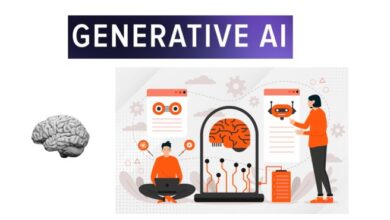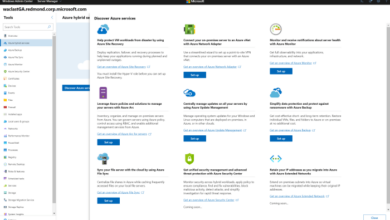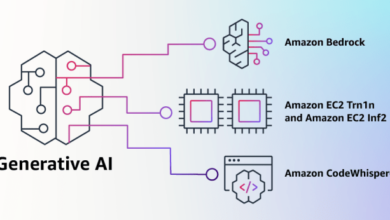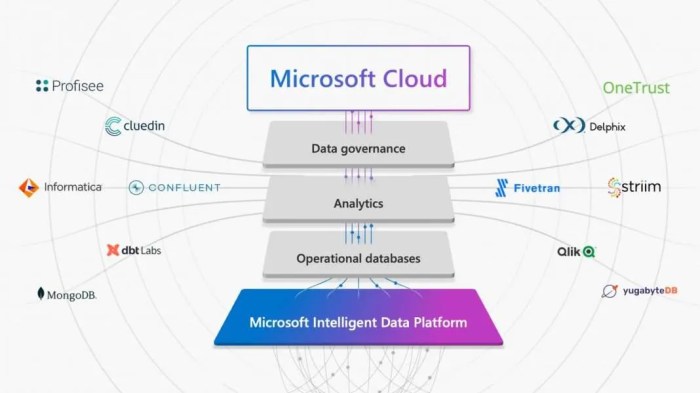
Microsoft Intelligent Data Platform: Powering Data-Driven Insights
Microsoft Intelligent Data Platform (MIDP) is a comprehensive suite of cloud-based services designed to empower organizations with the ability to collect, store, analyze, and visualize data at scale. It brings together a powerful combination of tools, including Azure Data Lake Storage, Azure Synapse Analytics, Azure Databricks, and Power BI, to unlock valuable insights from data and drive better business decisions.
MIDP provides a unified platform for managing the entire data lifecycle, from ingestion and transformation to storage, analysis, and visualization. It offers a flexible and scalable architecture that can accommodate various data sources, volumes, and complexities. Whether you’re a data engineer, data scientist, or business analyst, MIDP provides the tools and capabilities you need to extract meaningful insights from your data.
Introduction to Microsoft Intelligent Data Platform
The Microsoft Intelligent Data Platform (MIDP) is a comprehensive suite of cloud-based services designed to empower organizations to extract valuable insights from their data. It provides a unified platform for data ingestion, storage, processing, and analysis, enabling businesses to make data-driven decisions and improve operational efficiency.MIDP offers a comprehensive set of tools and services for managing, analyzing, and visualizing data.
It provides a robust foundation for building modern data solutions that cater to diverse business needs.
Core Components of MIDP
MIDP comprises several core components, each playing a crucial role in the data lifecycle.
- Azure Data Lake Storage: A highly scalable and secure data lake service for storing vast amounts of data in its raw format. It supports various data formats and provides a unified storage layer for all data sources. Azure Data Lake Storage ensures data availability and durability, making it ideal for storing data for long-term retention and analysis.
- Azure Synapse Analytics: A fully managed, cloud-based data warehouse that offers high-performance query processing and analytics capabilities. Azure Synapse Analytics combines the power of a data warehouse with the flexibility of a data lake, enabling organizations to perform complex data analysis and generate actionable insights.
- Azure Databricks: A fully managed Apache Spark-based analytics platform that provides a collaborative environment for data scientists and engineers. Azure Databricks simplifies the process of developing and deploying machine learning models and data pipelines, accelerating the time to value for data-driven projects.
- Power BI: A business intelligence and data visualization tool that allows users to create interactive dashboards and reports. Power BI connects to various data sources, including Azure Data Lake Storage and Azure Synapse Analytics, providing a comprehensive view of data insights.
The Microsoft Intelligent Data Platform is a powerful tool for managing and analyzing data, helping businesses gain insights and make better decisions. But sometimes, you need a break from the world of data and analytics. Why not treat yourself to something beautiful?
Check out this amazing 20% off sale on silver-plated cutlery from Newbridge Silverware. After all, a little indulgence can make you appreciate the power of the Microsoft Intelligent Data Platform even more!
It empowers users to explore data, identify trends, and make informed decisions.
Benefits of Using MIDP
MIDP offers numerous benefits for organizations looking to leverage data for better decision-making and business outcomes.
- Unified Data Platform: MIDP provides a unified platform for managing data across its lifecycle, from ingestion to analysis and visualization. This eliminates the need for disparate tools and simplifies data management processes.
- Scalability and Flexibility: MIDP’s cloud-based architecture offers scalability and flexibility to accommodate growing data volumes and evolving business requirements. Organizations can easily scale resources up or down based on their needs, ensuring optimal performance and cost efficiency.
- Enhanced Data Security: MIDP incorporates robust security features to protect sensitive data. Azure Data Lake Storage, Azure Synapse Analytics, and Azure Databricks offer advanced security measures, including access control, encryption, and compliance with industry standards.
- Accelerated Insights: MIDP’s powerful analytics capabilities enable organizations to gain insights from data faster. Azure Synapse Analytics provides high-performance query processing, while Azure Databricks simplifies machine learning model development, allowing for quicker analysis and decision-making.
- Improved Collaboration: MIDP fosters collaboration among data scientists, engineers, and business users. Azure Databricks provides a collaborative environment for developing and deploying data pipelines, while Power BI enables users to share insights and dashboards with stakeholders.
Data Ingestion and Transformation
Getting data into your Microsoft Intelligent Data Platform (MIDP) is the first step in your data journey. It’s like gathering ingredients for a delicious meal. You need the right data, in the right format, to make the most of your analytics and AI capabilities.
Data Ingestion Methods
There are various ways to bring data into your MIDP, each with its own strengths and use cases.
- Data Pipelines:Data pipelines are automated processes that move data from source systems to your MIDP. They can handle various data formats, including structured, semi-structured, and unstructured data. Azure Data Factory is a powerful tool for building and managing data pipelines.
It allows you to define data sources, transformations, and destinations in a visual interface, making it easier to manage complex data ingestion processes.
- APIs:APIs (Application Programming Interfaces) allow you to directly connect to data sources and retrieve data in real-time. This is useful for applications that require live data feeds, such as dashboards and online analytics. Azure Data Factory provides connectors to various popular APIs, simplifying the process of integrating data from external systems.
- Connectors:Connectors are pre-built integrations that streamline data ingestion from specific data sources. Azure Data Factory offers a wide range of connectors for databases, cloud storage services, social media platforms, and more. This allows you to quickly and easily bring data into your MIDP without having to write custom code.
Data Storage and Management
![]()
The Microsoft Intelligent Data Platform (MIDP) leverages Azure Data Lake Storage (ADLS) for storing massive datasets. ADLS offers a highly scalable and cost-effective solution for handling large volumes of data, making it ideal for storing and managing data from various sources within MIDP.
Azure Data Lake Storage Tiers
Azure Data Lake Storage provides different storage tiers to cater to varying data access patterns and cost considerations.
- Hot Tier:This tier is designed for frequently accessed data. It offers the lowest latency and highest throughput, making it suitable for real-time analytics and operational workloads.
- Cool Tier:This tier is ideal for data that is accessed less frequently but still needs to be readily available. It provides a balance between cost and performance, making it suitable for long-term data retention and historical analysis.
- Archive Tier:This tier is designed for data that is rarely accessed and can be retrieved within hours. It offers the lowest cost per GB, making it suitable for long-term archival purposes.
Data Governance and Security
MIDP emphasizes data governance and security to ensure data integrity, compliance, and protection.
- Access Control:ADLS supports fine-grained access control using Azure Active Directory (Azure AD) and role-based access control (RBAC). This allows administrators to define specific permissions for users and groups, limiting access to sensitive data.
- Data Encryption:ADLS offers both data at rest and data in transit encryption. Data at rest encryption ensures that data is encrypted while stored in ADLS, while data in transit encryption protects data during transfer between ADLS and other services. This helps to prevent unauthorized access and data breaches.
- Data Masking:Data masking can be applied to sensitive data to protect it from unauthorized access. This involves replacing sensitive data with non-sensitive values, while still allowing authorized users to access and analyze the data.
- Data Auditing:MIDP provides tools for auditing data access and modifications. This helps to track data usage patterns and identify any potential security breaches.
Data Analysis and Visualization
Once you’ve ingested, transformed, and stored your data in the Microsoft Intelligent Data Platform, the next step is to analyze it and extract meaningful insights. This section delves into the powerful tools within the platform that enable you to perform complex data analysis and visualize your findings effectively.
Azure Synapse Analytics for Data Analysis
Azure Synapse Analytics is a limitless analytics service that brings together data warehousing and big data analytics. It provides a unified platform for querying, analyzing, and visualizing data, allowing you to unlock valuable insights from your data. Azure Synapse Analytics offers several capabilities that make it ideal for complex data analysis tasks:
- Scalable and High-Performance Querying:Azure Synapse Analytics is built on a massively parallel processing (MPP) architecture, enabling it to handle large datasets and complex queries with exceptional speed and efficiency. It allows you to analyze data in real-time or near real-time, providing faster insights and decision-making.
- Unified Data Access:Azure Synapse Analytics allows you to query data across different data sources, including Azure Data Lake Storage, Azure SQL Database, and other external data sources. This unified access eliminates data silos and provides a comprehensive view of your data.
- Data Exploration and Discovery:With its built-in data exploration features, Azure Synapse Analytics helps you understand your data better. You can easily explore data patterns, identify trends, and uncover hidden relationships.
- Machine Learning Integration:Azure Synapse Analytics seamlessly integrates with Azure Machine Learning services, allowing you to build and deploy machine learning models directly on your data. This enables you to extract predictive insights and automate data-driven decision-making.
Azure Databricks for Collaborative Data Science
Azure Databricks is a collaborative data science and machine learning platform built on Apache Spark. It provides a unified environment for data engineers, data scientists, and machine learning engineers to work together on data projects. Azure Databricks offers a collaborative environment for data science and machine learning, facilitating the following:
- Shared Workspace:Azure Databricks provides a shared workspace where teams can collaborate on data projects, share code, and manage resources. This fosters efficient teamwork and reduces the time required to develop and deploy data-driven solutions.
- Interactive Notebooks:Azure Databricks utilizes interactive notebooks that allow data scientists to write and execute code, visualize data, and share their findings. This interactive approach enables faster experimentation and exploration of data.
- Machine Learning Libraries:Azure Databricks comes with a wide range of machine learning libraries, including TensorFlow, PyTorch, and scikit-learn, enabling data scientists to build and deploy advanced machine learning models.
- Scalable and Secure Infrastructure:Azure Databricks runs on a secure and scalable infrastructure, ensuring that your data is protected and your projects can handle large volumes of data.
Power BI for Interactive Dashboards and Visualizations
Power BI is a business intelligence and data visualization tool that helps you create interactive dashboards and reports to present data insights effectively. It connects to various data sources, including Azure Synapse Analytics and Azure Databricks, and allows you to visualize your data in various ways.
Power BI enables you to:
- Connect to Data:Power BI can connect to various data sources, including Azure Synapse Analytics, Azure Databricks, and other cloud-based and on-premises data sources.
- Create Interactive Dashboards:Power BI provides a rich set of visualization tools, enabling you to create interactive dashboards that display key performance indicators (KPIs), charts, graphs, and other visualizations.
- Share Insights:Power BI allows you to share your dashboards and reports with others, making data insights accessible to a wider audience. You can publish your reports on the web, mobile devices, or embed them in other applications.
- Analyze Data with AI:Power BI integrates with Azure AI services, allowing you to leverage machine learning and artificial intelligence to gain deeper insights from your data.
Artificial Intelligence and Machine Learning
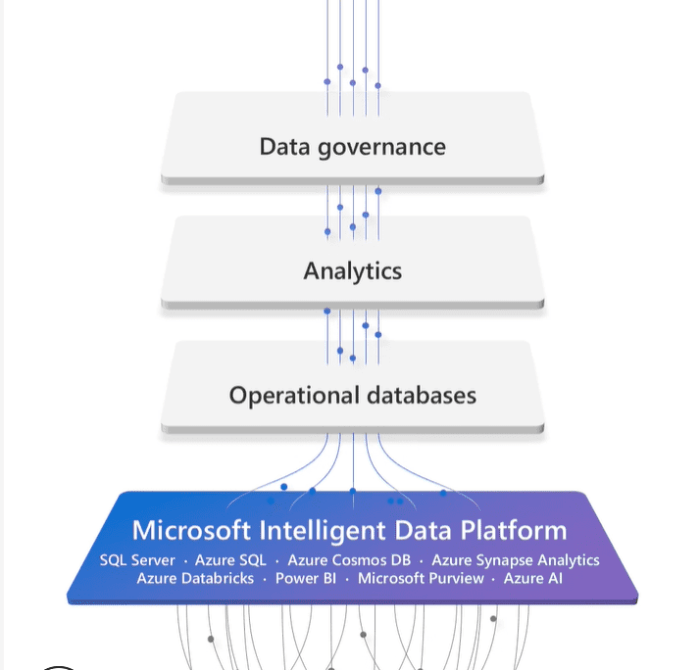
The Microsoft Intelligent Data Platform (MIDP) seamlessly integrates with Azure Cognitive Services, a suite of AI and machine learning (ML) APIs, empowering data professionals to unlock deeper insights and automate complex tasks. This integration unlocks the potential for advanced data analysis, predictive modeling, and intelligent application development.
Microsoft Intelligent Data Platform is a powerful suite of tools for managing and analyzing your data, but you need to understand where that data is coming from. Setting up Google Analytics 4 is crucial for tracking website traffic and user behavior, setup google analytics 4 , which then provides valuable insights that can be integrated into your Microsoft Intelligent Data Platform for deeper analysis and decision-making.
Integrating with Azure Cognitive Services
Azure Cognitive Services provides a range of pre-trained AI models and APIs that can be leveraged within MIDP to enhance data analysis and insights. These services offer capabilities for natural language processing (NLP), computer vision, speech recognition, and more.
Microsoft’s Intelligent Data Platform is a powerful tool for managing and analyzing data, but sometimes even the most advanced technology needs a little inspiration. That’s why I was so intrigued by the recent name change of project athia is now forspoken , a game that promises to be a visually stunning and engaging experience.
Perhaps the developers were looking for a way to inject some of that same creative energy into their data platform, making it more intuitive and user-friendly. Whatever the reason, it’s clear that the world of data is becoming increasingly intertwined with the world of entertainment, and that’s something I’m excited to see unfold.
- Natural Language Processing (NLP):MIDP can use Azure Cognitive Services’ NLP APIs to analyze text data, extract key insights, and understand sentiment. This allows for sentiment analysis of customer reviews, topic extraction from documents, and automated text summarization.
- Computer Vision:By integrating with Azure Cognitive Services’ computer vision APIs, MIDP can analyze images and videos to extract valuable information. This can be used for object detection, facial recognition, and image classification, enabling applications such as automated image tagging and visual search.
- Speech Recognition:MIDP can leverage Azure Cognitive Services’ speech recognition APIs to transcribe audio data into text, allowing for analysis of audio recordings, transcription of meetings, and voice-activated applications.
Machine Learning Models for Predictive Analytics and Automated Decision-Making
MIDP provides a robust platform for building and deploying machine learning models, enabling predictive analytics and automated decision-making.
- Predictive Analytics:MIDP allows users to build predictive models using Azure Machine Learning services. These models can forecast future trends, identify potential risks, and optimize business processes. For instance, a retail company can use MIDP to build a model that predicts customer churn based on historical data, enabling proactive measures to retain valuable customers.
- Automated Decision-Making:MIDP enables the integration of machine learning models into business workflows, automating decision-making processes. For example, a financial institution can use MIDP to build a model that automatically approves or denies loan applications based on pre-defined criteria, reducing manual effort and improving efficiency.
Building Intelligent Applications Powered by AI
MIDP facilitates the development of intelligent applications that leverage the power of AI.
- Personalized Recommendations:MIDP can be used to build recommendation engines that provide personalized suggestions to users based on their preferences and past behavior. This can be applied to e-commerce platforms, streaming services, and other applications that require personalized experiences.
- Fraud Detection:MIDP can be used to build fraud detection systems that identify suspicious activities in real-time. These systems can analyze transactional data, identify patterns, and alert security teams to potential fraudulent transactions.
- Predictive Maintenance:MIDP can be used to develop predictive maintenance models that anticipate equipment failures and schedule preventive maintenance, reducing downtime and improving operational efficiency.
Real-World Applications of MIDP
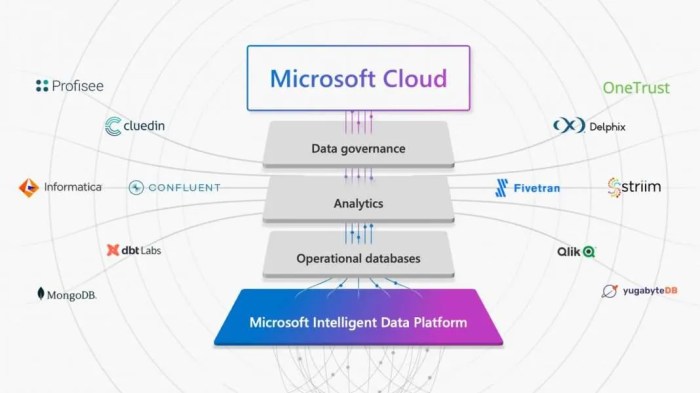
The Microsoft Intelligent Data Platform (MIDP) is a comprehensive suite of cloud-based services designed to empower businesses of all sizes to harness the power of data. From ingesting and storing vast amounts of information to analyzing it with advanced tools and building intelligent applications, MIDP offers a complete solution for modern data management and analytics.
Let’s explore how MIDP is transforming industries across the globe with its real-world applications.
MIDP in Action: Industry Use Cases
The power of MIDP lies in its ability to address diverse data challenges across industries. Here are some examples of how MIDP is used to drive innovation and efficiency:
| Industry | Use Case | Data Source | MIDP Components |
|---|---|---|---|
| Healthcare | Predictive Analytics for Patient Readmission | Patient records, medical history, treatment data | Azure Synapse Analytics, Azure Machine Learning, Power BI |
| Finance | Fraud Detection and Risk Management | Transaction history, customer data, market trends | Azure Databricks, Azure Cosmos DB, Azure Sentinel |
| Retail | Personalized Customer Recommendations | Purchase history, customer demographics, product data | Azure Data Factory, Azure Data Lake Storage, Azure Cognitive Services |
| Manufacturing | Predictive Maintenance for Industrial Equipment | Sensor data, equipment logs, maintenance records | Azure IoT Hub, Azure Stream Analytics, Azure SQL Database |
Best Practices and Considerations
Successfully implementing a Microsoft Intelligent Data Platform (MIDP) solution requires careful planning, design, and ongoing management. This section delves into best practices, challenges, and strategies for maximizing the effectiveness of your MIDP deployment.
Data Modeling
Effective data modeling is crucial for a successful MIDP implementation. This involves defining the structure and relationships between data entities to ensure data integrity, consistency, and efficient querying.
- Start with a clear understanding of business requirements. This involves identifying the key data elements, their relationships, and how they will be used to support business goals.
- Utilize established data modeling techniques. Techniques like Entity-Relationship Diagrams (ERDs) and dimensional modeling help visualize data relationships and guide the design process.
- Consider data governance and security. Implement data quality checks, access controls, and data masking to protect sensitive information and ensure data integrity.
Security
Data security is paramount in any MIDP implementation. Implementing robust security measures protects sensitive data from unauthorized access and ensures compliance with industry regulations.
- Utilize Azure Active Directory (Azure AD) for user authentication and authorization. Azure AD provides a centralized identity management system, enabling granular access control and auditing capabilities.
- Encrypt data at rest and in transit. This includes encrypting data stored in Azure databases, data warehouses, and data lakes, as well as securing data transmission between services.
- Implement network security measures. Use firewalls, network segmentation, and intrusion detection systems to protect the MIDP environment from external threats.
- Regularly monitor and update security policies. Stay informed about evolving security threats and vulnerabilities, and update security measures accordingly.
Performance Optimization
Optimizing MIDP performance is crucial for ensuring efficient data processing, analysis, and retrieval. This involves identifying performance bottlenecks and implementing strategies to improve query execution times and reduce resource consumption.
- Optimize data storage and retrieval. Choose appropriate storage solutions, such as Azure SQL Database or Azure Cosmos DB, based on data characteristics and performance requirements.
- Implement data partitioning and indexing. This helps improve query performance by breaking down large datasets into smaller, more manageable chunks and creating indexes for faster data retrieval.
- Utilize query optimization techniques. Techniques like query hints, parameter sniffing, and query caching can significantly improve query execution times.
- Monitor and analyze performance metrics. Regularly monitor key performance indicators (KPIs), such as query execution time, resource utilization, and data latency, to identify potential bottlenecks and areas for optimization.
Managing and Scaling Data, Microsoft intelligent data platform
Managing and scaling data within MIDP presents unique challenges, as data volumes and complexity continue to grow. This section Artikels strategies for effectively managing and scaling your MIDP environment.
- Utilize cloud-based data storage and processing. Cloud platforms like Azure provide scalable infrastructure and services, enabling you to handle large data volumes and complex workloads without the need for significant upfront investment.
- Implement data partitioning and sharding. This technique breaks down large datasets into smaller, more manageable chunks, distributing them across multiple servers or databases to improve scalability and performance.
- Leverage data caching and replication. Caching frequently accessed data in memory or local storage can significantly improve query performance, while replication can create copies of data across multiple locations for high availability and disaster recovery.
- Consider data virtualization. Data virtualization allows you to access and integrate data from multiple sources without physically moving or copying the data, simplifying data management and reducing data duplication.
Continuous Monitoring and Improvement
Continuous monitoring and improvement are essential for ensuring the long-term success of your MIDP deployment. This involves regularly monitoring system health, performance, and data quality, and implementing corrective actions to address any issues.
- Implement comprehensive monitoring solutions. Use tools like Azure Monitor to track system metrics, performance indicators, and data quality metrics, providing insights into system health and potential issues.
- Establish clear service level agreements (SLAs). SLAs define performance and availability expectations for your MIDP deployment, providing a baseline for monitoring and improvement efforts.
- Utilize automated alerts and notifications. Configure alerts to notify you of potential issues, allowing for proactive intervention and minimizing downtime.
- Continuously analyze and optimize data pipelines. Regularly review data pipelines to identify bottlenecks, optimize processing steps, and improve data quality.


